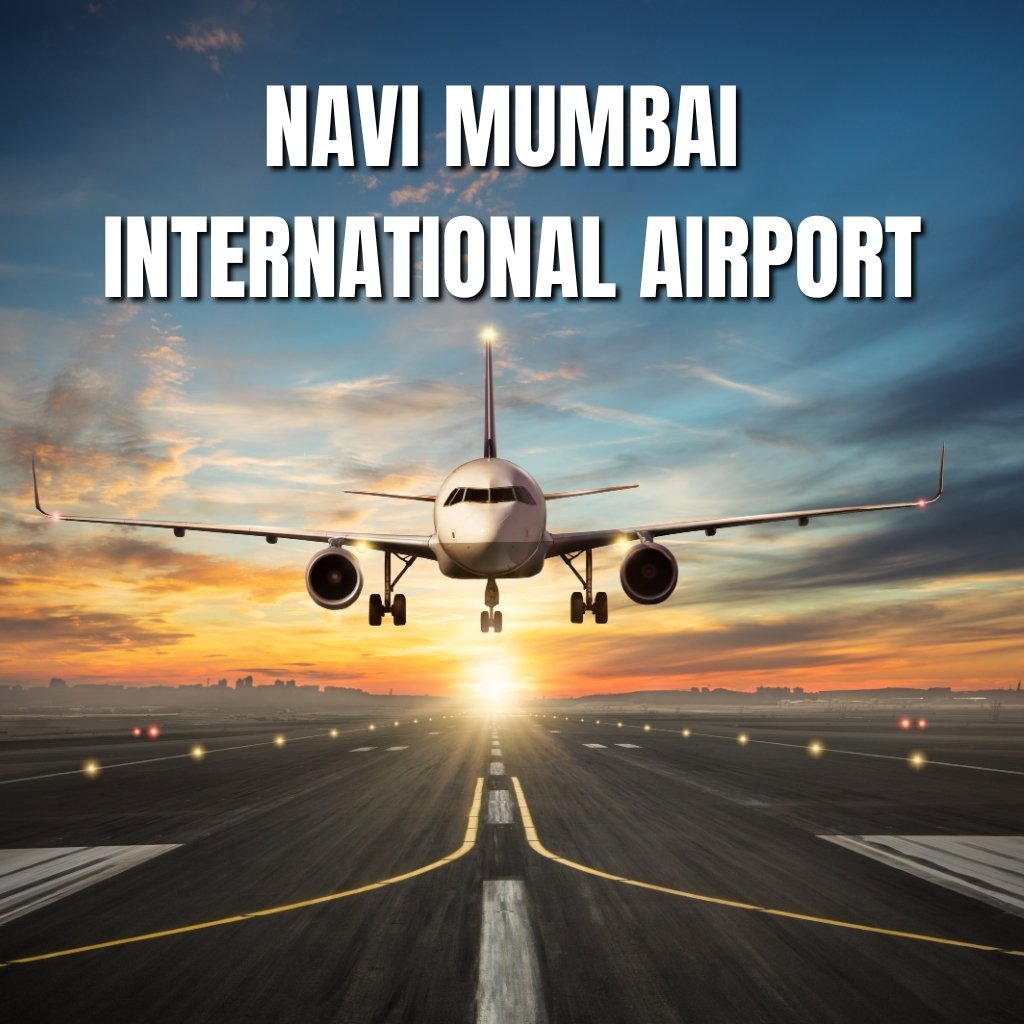
Navi Mumbai Airport: Upcoming Game-Changer for India
Get the latest updates on Navi Mumbai International Airport – a mega project set to enhance connectivity, boost real estate & transform Mumbai’s travel hub.
Why Navi Mumbai International Airport is a Game Changer for India’s Aviation : Navi Mumbai International Airport is set to transform India’s aviation sector by easing congestion at Mumbai’s existing airport and boosting regional connectivity. This modern, eco-friendly airport is designed to accommodate 60 million passengers annually upon full completion, making it one of the most significant infrastructure projects in the country.
A Vision for the Future
The development of Navi Mumbai International Airport is a testament to India’s ambition to create world-class infrastructure. Located strategically in the Panvel-Uran region, it is designed to ease the pressure on the Chhatrapati Shivaji Maharaj International Airport, which has been operating beyond its capacity. This new airport is not just about handling air traffic but also about fostering economic growth, urban development, and better global connectivity.
Strategic Location and Connectivity
One of the major advantages of the Navi Mumbai International Airport is its seamless connectivity. Situated near Panvel, the airport is well-linked to Mumbai and the rest of Maharashtra through multiple transport networks. The Mumbai Trans Harbour Link (MTHL) will provide a direct connection between South Mumbai and Navi Mumbai, making travel time significantly shorter. The Navi Mumbai Metro Line 1 will ensure a smooth commute from Belapur, Kharghar, and Taloja. Additionally, the suburban railway network, with nearby stations like Panvel, Ulwe, and Kharkopar, will offer easy access to the airport. The airport is also in close proximity to major highways such as the Mumbai-Pune Expressway and Sion-Panvel Highway. Future integration with water transport services is also planned to enhance accessibility.
Modern Infrastructure and World-Class Facilities
The airport spans 1,160 hectares and boasts some of the most advanced facilities in the country. Designed by Zaha Hadid Architects, the terminals will feature a lotus-inspired design, symbolizing elegance and efficiency. The airport will have two parallel runways designed to accommodate large aircraft, including the Airbus A380. Upon full completion, it will be able to handle 60 million travelers annually. A dedicated cargo hub will enhance trade and logistics operations, while the ATC tower will be equipped with advanced air traffic management systems. Sustainability features include solar energy, rainwater harvesting, and eco-friendly practices. Additionally, luxury lounges, retail spaces, high-end shopping, fine dining, and premium lounge facilities will be available for passengers.
Phase-Wise Development and Timeline
The Navi Mumbai International Airport will be developed in multiple phases. Phase 1, expected to be completed by 2025, will see the operation of one terminal and one runway. Phase 2, between 2028-2030, will include the expansion of terminals and the addition of a second runway. The airport will be fully completed by 2032, at which point it will be able to handle 60 million passengers annually.
Economic and Regional Impact
The airport is not just an aviation hub but a major driver of economic growth in the Mumbai Metropolitan Region (MMR). Its development will generate over 3 lakh direct and indirect jobs, boosting employment opportunities. The real estate market in areas like Ulwe, Panvel, and Dronagiri is experiencing a boom due to increased demand. The airport will also strengthen Mumbai’s position as a global commercial hub, facilitate tourism growth, and improve logistics and supply chain operations through its cargo hub.
Challenges and Roadblocks
Despite its ambitious scope, the Navi Mumbai International Airport has faced several challenges over the years. Land acquisition issues led to delays due to compensation and rehabilitation concerns. Environmental concerns arose as clearances were required for wetlands and mangroves. Financial delays and changes in project ownership slowed down progress, while multiple regulatory approvals were needed to move the project forward. However, significant strides have been made in overcoming these obstacles, ensuring that work proceeds as planned.
Interesting Facts About Navi Mumbai International Airport
This airport will be India’s first digital airport, incorporating AI-driven passenger services and air traffic management. It is a Greenfield Airport, built from scratch with the latest aviation technology. The airport is designed to accommodate the Airbus A380, one of the largest aircraft in the world. Its infrastructure is climate-resistant, ensuring that it can withstand heavy monsoon rains and adverse weather conditions. Additionally, the airport will feature state-of-the-art security, including biometric check-ins, automated baggage handling, and advanced surveillance systems.
The Road Ahead: A New Era for Indian Aviation
The Navi Mumbai International Airport represents more than just an expansion of India’s aviation sector. It is a catalyst for urban transformation, economic prosperity, and global connectivity. Once completed, it will stand as a symbol of India’s progress in infrastructure and modernization, setting new benchmarks in the aviation industry.
As India moves towards becoming a global economic powerhouse, the Navi Mumbai International Airport will play a critical role in shaping the future of travel, trade, and transportation. With its cutting-edge facilities, strategic location, and forward-thinking design, this airport is truly a game-changer in India’s aviation landscape.
Stay tuned for more updates on the Navi Mumbai International Airport and its impact on India’s growing infrastructure!

Should You Invest in Real Estate Near Navi Mumbai International Airport?
With the rapid development of Navi Mumbai International Airport, investors and homebuyers are eyeing the surrounding areas as potential hotspots for real estate investment. The airport is expected to boost economic growth, enhance connectivity, and increase property demand. But is investing near Navi Mumbai International Airport a smart move? Let’s analyze the factors that can help you make an informed decision.
Impact of Navi Mumbai International Airport on Real Estate
The upcoming Navi Mumbai International Airport is one of India’s most ambitious infrastructure projects. It is expected to handle 60 million passengers annually, significantly reducing congestion at Chhatrapati Shivaji Maharaj International Airport. This major development has already influenced property prices in nearby areas such as Ulwe, Panvel, Dronagiri, and Taloja, and this trend is expected to continue as the airport nears completion.
Why Investing Near Navi Mumbai International Airport is a Good Idea
1. Skyrocketing Property Values
Real estate prices around airport zones tend to appreciate significantly. With Navi Mumbai International Airport set to become fully operational by 2032, early investors can expect high returns due to increased demand for residential and commercial spaces.
2. Excellent Connectivity
The airport will have direct links to major transport corridors, making commuting easier for residents and businesses. The Mumbai Trans Harbour Link (MTHL), Navi Mumbai Metro, Sion-Panvel Highway, and the suburban railway network will enhance accessibility to the airport region, further increasing property demand.
3. Commercial and Job Opportunities
The airport will generate over 3 lakh direct and indirect jobs, attracting working professionals and businesses. With the development of business parks, IT hubs, and logistics centers, the demand for housing and commercial spaces will rise, making real estate investment a lucrative option.
4. Boost in Infrastructure and Lifestyle Amenities
The surrounding areas will witness rapid urbanization, including the development of schools, hospitals, malls, hotels, and entertainment hubs. These developments will enhance the overall lifestyle quotient, making it a desirable place to live and invest.
5. Growing Rental Market
With an influx of professionals and businesses, rental demand will increase, providing investors with steady rental income. Locations like Ulwe, Panvel, and Dronagiri are already seeing a rise in rental rates due to their proximity to the upcoming airport.
Potential Risks and Challenges
1. Land Acquisition and Regulatory Approvals
While the project is progressing, past delays due to land acquisition issues and environmental clearances have raised concerns. Investors should ensure that their chosen properties have all necessary approvals before investing.
2. Initial Infrastructure Development May Take Time
Although the Navi Mumbai International Airport promises modern infrastructure, full-fledged development of roads, metro lines, and commercial hubs might take a few years. Investors looking for short-term gains may need to be patient.
3. Market Speculation and Price Hikes
Due to high anticipation, some areas might witness artificial price inflation driven by speculators. Buyers should conduct thorough research and avoid overpaying for properties.
Best Locations to Invest Near Navi Mumbai International Airport
Ulwe – One of the fastest-growing real estate markets with planned metro connectivity.
Panvel – Established locality with upcoming commercial and residential projects.
Dronagiri – Emerging as a key investment zone due to proximity to JNPT and logistics hubs.
Taloja – Affordable housing with good connectivity to Kharghar and upcoming metro lines.
Kharkopar – Developing residential hub with increasing demand for rental properties.
Final Verdict: Is It Worth Investing?
Investing in real estate near Navi Mumbai International Airport presents a promising opportunity for long-term capital appreciation, rental income, and business growth. However, investors should conduct due diligence, verify property approvals, and assess infrastructure progress before making a purchase.
If you are looking for a future-ready investment in one of India’s fastest-growing regions, real estate near Navi Mumbai International Airport is undoubtedly a smart choice. As the airport becomes operational, property prices and demand are expected to surge, making it an ideal time to invest now.
Stay tuned for more updates on the Navi Mumbai International Airport and its impact on real estate investments!

The Hidden Challenges of Navi Mumbai International Airport :
The Navi Mumbai International Airport is hailed as a transformative infrastructure project that promises to ease congestion, boost connectivity, and propel economic growth in the Mumbai Metropolitan Region. However, while the project has numerous advantages, it also comes with its share of drawbacks. From environmental concerns to financial implications, the airport presents certain challenges that should not be overlooked.
Environmental Concerns and Ecological Impact
One of the most debated issues surrounding the Navi Mumbai International Airport is its environmental impact. The site is located in an ecologically sensitive area, surrounded by wetlands and mangroves, which serve as natural barriers against flooding. The large-scale deforestation and land reclamation required for construction could lead to long-term ecological damage. Environmental activists and experts have raised concerns about the destruction of these natural buffers, which may increase the risk of flooding in nearby areas, particularly during heavy monsoons.
Displacement of Local Communities
Another major drawback of the Navi Mumbai International Airport project is the displacement of thousands of villagers who lived in the region for generations. Land acquisition has been a contentious issue, with local residents demanding fair compensation and rehabilitation. Many affected families have had to relocate to new settlements, facing disruptions in their livelihood, education, and social structures. Although compensation packages have been provided, the emotional and economic cost of displacement remains high for many locals.
High Real Estate Costs and Market Speculation
While the airport is expected to boost real estate growth in Navi Mumbai, it has also led to rampant speculation, significantly inflating property prices. Investors and developers have rushed to purchase land in anticipation of future demand, driving prices to unrealistic levels. This rapid appreciation might make housing unaffordable for the middle class, leading to a property bubble. Additionally, not all infrastructure projects related to the airport are completed yet, meaning that investors could face prolonged waiting periods before seeing returns on their investments.
Traffic Congestion and Infrastructure Burden
Although the Navi Mumbai International Airport aims to improve connectivity, the increased traffic it will bring could overwhelm existing infrastructure. The Sion-Panvel Highway, Mumbai-Pune Expressway, and the local railway network will need substantial upgrades to handle the surge in passenger and cargo traffic. While projects like the Mumbai Trans Harbour Link (MTHL) and metro expansions are under development, their timely completion remains uncertain. If infrastructure improvements do not keep pace with the airport’s expansion, commuters may face severe congestion and long travel times.
Delays and Cost Overruns
Like many large-scale infrastructure projects in India, the Navi Mumbai International Airport has faced multiple delays due to bureaucratic hurdles, funding issues, and environmental clearances. Initially proposed over two decades ago, the project has seen multiple changes in developers and financial partners. The cost of the project has escalated significantly over time, with the estimated budget now reaching ₹16,000 crore. These cost overruns may eventually translate into higher operational costs, potentially leading to expensive airfares and airport services.
Uncertainty Over Completion Timeline
Although Phase 1 of the Navi Mumbai International Airport is expected to be operational by 2025, past delays and ongoing construction challenges raise concerns about further postponements. Any delay in completion would not only affect businesses and travelers relying on the new airport but also impact real estate developers and investors banking on rapid development in the surrounding areas.
Economic Viability and Competition with Mumbai Airport
While the Navi Mumbai International Airport is designed to complement the Chhatrapati Shivaji Maharaj International Airport (CSMIA) in Mumbai, there is speculation about how effectively the two airports will share traffic. Mumbai’s existing airport is already well-established, and shifting international airlines and major carriers to the new airport may take longer than expected. Additionally, competition between the two airports could lead to financial stress for airlines and businesses, especially if passenger demand does not meet projected expectations

The Navi Mumbai International Airport is set to transform the region by generating extensive employment opportunities. With its construction and upcoming operations, job prospects will rise in aviation, hospitality, logistics, real estate, and infrastructure. The airport will require skilled professionals such as pilots, ground staff, air traffic controllers, and aircraft maintenance engineers. Additionally, the hospitality industry will see a boom, with hotels, restaurants, and travel agencies benefiting from increased passenger traffic.
The logistics and cargo sector will expand significantly, requiring warehouse managers, freight handlers, and supply chain professionals. Infrastructure and real estate development will also surge, creating employment in construction, property management, and retail services. The rise of IT and customer support roles in airport operations will further add to job growth in the region.
Security services will also see a surge in demand, creating opportunities for security personnel, customs officers, and immigration officials. Retail jobs within the airport, including duty-free stores, shopping outlets, and food courts, will open up employment avenues for sales executives, cashiers, and customer service representatives. Transport services such as taxi drivers, shuttle operators, and metro staff will also experience significant job growth.
Local communities, especially in Panvel, Ulwe, and Dronagiri, will benefit immensely. With the increase in job opportunities, residents will have access to stable employment without needing to migrate for work. Skill development initiatives and training centers will equip locals with necessary expertise, ensuring they are well-prepared for various roles in aviation, logistics, and hospitality. Small businesses will thrive due to heightened demand for transport, accommodations, and retail services, providing a boost to local entrepreneurship.
Infrastructure development around the airport, including better roads, metro connectivity, and commercial hubs, will further improve the quality of life for nearby residents. Property values in the surrounding areas are expected to rise, making real estate investment lucrative. The airport’s presence will not only provide immediate employment but also long-term economic sustainability, ensuring continuous growth in Navi Mumbai and its neighboring regions.
The Navi Mumbai International Airport is more than just an aviation hub—it is a gateway to economic prosperity. By generating thousands of jobs, enhancing regional infrastructure, and uplifting local businesses, it will significantly improve living standards and create a thriving ecosystem for employment and growth.
